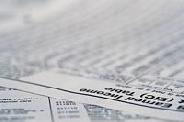
 |
|
| Financial Terms | |
| Free-on-Board (FOB) Shipping Point |
|
Information about financial, finance, business, accounting, payroll, inventory, investment, money, inventory control, stock trading, financial advisor, tax advisor, credit.
Main Page: tax advisor, money, investment, business, inventory control, stock trading, inventory, finance, |
Definition of Free-on-Board (FOB) Shipping Point
Free-on-Board (FOB) Shipping PointA shipping arrangement agreed to between buyer and
Related Terms:Arbitrage-free option-pricing modelsYield curve option-pricing models. Basis pointIn the bond market, the smallest measure used for quoting yields is a basis point. Each percentage Big BoardA nickname for the New York Stock Exchange. Also known as The Exchange. More than 2,000 Bond pointsA conventional unit of measure for bond prices set at $10 and equivalent to 1% of the $100 face Cash-flow break-even pointThe point below which the firm will need either to obtain additional financing Delivery pointsThose points designated by futures exchanges at which the financial instrument or Free cash flowsCash not required for operations or for reinvestment. Often defined as earnings before  Free floatAn exchange rate system characterized by the absence of government intervention. Also known as Free on boardImplies that distributive services like transport and handling performed on goods up to the Free reservesExcess reserves minus member bank borrowings at the Fed. Free riderA follower who avoids the cost and expense of finding the best course of action and by simply PointThe smallest unit of price change quoted or, one one-hundredth of a percent. Related: minimum price Point and figure chartA price-only chart that takes into account only whole integer changes in price, i.e., a Price value of a basis point (PVBP)Also called the dollar value of a basis point, a measure of the change in Riskless or risk-free assetAn asset whose future return is known today with certainty. The risk free asset is Risk-free assetAn asset whose future return is known today with certainty.  Risk-free rateThe rate earned on a riskless asset. Tax free acquisitionA merger or consolidation in which 1) the acquirer's tax basis in each asset whose Breakeven pointThe point at which total costs equal total revenue, i.e. where there is neither a profit nor a loss. breakeven pointThe annual sales volume level at which total contribution free cash flowGenerally speaking, this term refers to cash flow from Basis PointOne one-hundredth of one percent Free Cash FlowThe funds available for distribution to the capital providers of the Risk-free RateThe rate of return on an investment with known future benefits; a break-even point (BEP)the level of activity, in units or dollars, at which total revenues equal total costs Cost Accounting Standards Board (CASB)a body established by Congress in 1970 to promulgate cost accounting North American Free Trade Agreement (NAFTA)an agreement among Canada, Mexico, and the United States establishing the North American free Trade Zone, with a resulting reduction in trade barriers order pointthe level of inventory that triggers the placement split-off pointthe point at which the outputs of a joint process are first identifiable or can be separated as individual products Basis pointOne hundredth of one percentage point, or 0.0001. Point and figure chartA financial chart usually used to plot asset price data. Breakeven pointThe sales level at which a company, division, or product line makes a Split-off pointThe point in a production process when clearly identifiable joint costs Basis PointOne one-hundredth of a percentage point, used to express variations in yields. For example, the difference between 5.36 percent and 5.38 percent is 2 basis points. Federal Reserve Boardboard of Governors of the Federal Reserve System. Free TradeThe absence of any government restrictions, such as tariffs or quotas, on imports or exports. Turning PointThe trough or peak of a business cycle. Free-on-Board (FOB) DestinationA shipping arrangement agreed to between buyer and Public Oversight BoardAn independent private-sector body that oversees the audit practices Material review boardA company committee typically comprising members representing Order penetration pointThe point in the production process when a product is Outbound stock pointA designated inventory location on the shop floor between Point-of-use deliveryA delivery of stock to a location in or near the shop floor Point-of-use storageThe storage of stock in a location in or near the shop floor StockpointAn inventory storage area used for short-term inventory staging. Risk-Free RateThe rate of return obtainable on government of Canada treasury bills. point of sale (POS)The terminal at which a customer uses his/her debit card to make a direct payment transaction. See also Interac Direct Payment. Related to : financial, finance, business, accounting, payroll, inventory, investment, money, inventory control, stock trading, financial advisor, tax advisor, credit. |